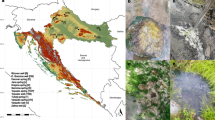Abstract
A microbial biofilm community was established over 971 days within gravel in an aquarium so as to model biofouling of an aquifer. When the water was allowed to evaporate slowly, white crystalline deposits, containing several carbonate and sulphate minerals including nesquehonite (MgCO3.3H2O), were seen at the highest points on the surface of the biofouled gravel. No such deposits occurred in regions lacking biofilms. These crystals appeared to originate from evaporation of dissolved salts which had migrated through the biofilm. Surfaceadherent microbial biofilms may conceivably provide a conduit for solute transport in porous media such as soils and aquifers.
Similar content being viewed by others
References
Beveridge, T.J. 1989 Role of cellular design in bacterial metal accumulation and mineralization.Annual Review of Microbiology 43, 147–171.
Cullimore, D.R. 1992Practical manual of groundwater microbiology. Chelsea, MI: Lewis Publishers.
Ferris, F.G., Schultze, S., Witten, T.C., Fyfe, W.S. & Beveridge, T.J. 1989 Metal interactions with microbial biofilms in acidic and neutral pH environments.Applied and Environmental Microbiology 55, 1249–1257.
Folk, R.L. 1993 SEM imaging of bacteria and nannobacteria in carbonate sediments and rocks.Journal of Sedimentary Petrology 63, 990–999.
International Center for Diffraction Data 1980 JCPDSmineral diffraction file. pp. 20–669. Swarthmore, PA: International Center for Diffraction Data.
Korber, D.R., Lawrence, J.R., Lappin-Scott, H.M. & Costerton, J.W. 1995 Growth of microorganisms on surfaces. InMicrobial biofilms, eds Lappin-Scott, H.M. & Costerton, J.W. pp. 15–45. Cambridge, UK: Cambridge University Press.
McLean, R.J.C. & Beveridge, T.J. 1990 Metal binding capacity of bacterial surfaces and their ability to form mineralized aggregates. InMicrobial mineral recovery, eds Ehrlich, H.L. & Brierley, C.L. pp. 185–222. New York: McGraw-Hill.
McLean, R.J.C, Fortin, D. & Brown, D.A. 1996 Microbial metalR.J.C. McLean, H.E. Jamieson and D.R. Cullimore binding mechanisms and their relation to nuclear waste disposal.Canadian Journal of Microbiology 42, 392–400.
Palache, C., Berman, H. & Frondel, C. 1951The System of Mineralogy. 7th edition, pp. 225–228. New York: John Wiley and Sons.
Tazaki, K., Ferris, F.G., Wiese, R.G. & Fyfe, W.S. 1992 Iron and graphite associated with fossil bacteria in chert.Chemical Geology 95, 313–325.
Author information
Authors and Affiliations
Corresponding author
Rights and permissions
About this article
Cite this article
McLean, R.J.C., Jamieson, H.E. & Cullimore, D.R. Formation of nesquehonite and other minerals as a consequence of biofilm dehydration. World J Microbiol Biotechnol 13, 25–28 (1997). https://doi.org/10.1007/BF02770803
Received:
Accepted:
Issue Date:
DOI: https://doi.org/10.1007/BF02770803




